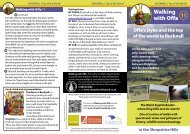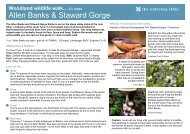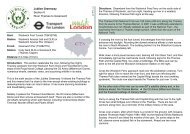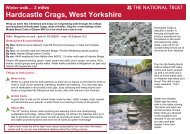Rodborough Common Butterfly Walk - Walk4Life
Rodborough Common Butterfly Walk - Walk4Life
Rodborough Common Butterfly Walk - Walk4Life
- No tags were found...
Create successful ePaper yourself
Turn your PDF publications into a flip-book with our unique Google optimized e-Paper software.
Into the heart of the Cotswolds – 2 ¾ miles<strong>Rodborough</strong> <strong>Common</strong>, StroudThe steep grassland slopes of <strong>Rodborough</strong> <strong>Common</strong> offer superb butterflying,walking and views over the Severn Estuary. Look out for over thirty varieties ofbutterfly, including rare species like the Duke of Burgundy and Adonis blue, thatcome here each summer to feed and breed on an amazing variety of wildflowers.Start: NT car park – maps: OS Landranger 162, Explorer 168 – grid ref: SO 850035Getting there and facilities…In the Cotswold Hills, south of Stroud and north of Minchinhampton <strong>Common</strong>:By bike: NCN route 45 follows Nailsworth stream at bottom of hill – 1 mile away to westBy train/bus: Stroud 1 mile away – from there, bus 28 (Stroud to Cirencester service)By car: just off the A419 Swindon to Stroud road, climb up hill via small steep roadsNearest WC at Stroud , two car parking areas on top of the common, pubs and icecream factory in <strong>Rodborough</strong> village.Look out for…t ButterfliesAdonis blue have been spectacularly successful recolonising <strong>Rodborough</strong> <strong>Common</strong>and are now widespread. Chalkhill blue and small blue also live here and it’s a top sitefor the Duke of Burgundy butterfly. If you’re lucky you may spot the green hairstreakand dingy skipper in spring. The marbled white is abundant in July.www.nationaltrust.org.uk/walksLook out for the vivid,electric, iridescent blue andblack vein ends of the Adonisblue. They have recentlyrecolonised the southernCotswolds after an absenceof forty years! Now,<strong>Rodborough</strong> is home toseveral colonies. The best isat Swellshill Bank.Pasque flowers bloom inspring, hence their namewhich means ‘Easter’ inFrench. They are extremelyscarce and only found in asmall area in southernEngland.Stephen Robson / NTPLt Wild flowers13 types of orchid can be found in the limestone grassland on the plateau top andslopes. The soil is rich in calcium and poor in nutrients, a combination that favoursdelicate plants over coarse and vigorous species. In spring, keep an eye out for earlypurple orchids and the striking pasque flower. They’re followed by blooming pyramidalorchids and autumn lady’s-tresses in late summer.t Belted Galloway cattleNote the white band around the body of this attractive, slightly fluffy-looking, breed.They graze the slopes nearly all year round. By keeping the grass short, they help usmaintain a good habitat for the wildlife. The Adonis blue has responded particularlywell to the cropped vegetation as they like short turf.t Laurie LeeThe writer of Cider with Rosie once wrote of Stroud, “If ever I saw blessing in the air Isee it now in this still early day”.<strong>Rodborough</strong> is one of thebest places in the UK for theDuke of Burgundy, with fiveseparate colonies along thelower slopes. They usually flyfrom the third week in Apriluntil late May.Matthew Oates / NT<strong>Rodborough</strong> <strong>Common</strong> was given to the National Trust in 1937 by akeen naturalist and lepidopterist (butterfly expert), Thomas BainbriggeFletcher. His butterflies are faring well…
Terrain and accessibility…2 ¾ miles (to Swellshill and back). The route follows natural grassytracks, open grassy hillsides and a quiet tarmac lane. An alternativequiet lane between points 2 and 3, on west side of the plateau, isexcellent for pushchairs and wheelchairs.<strong>Walk</strong> directions…1. From the car park, head southwest on a path skirting round thehouses on the summit of the plateau. Keep the houses on your left.ButterrowHill© Reproduced by permissionof Ordnance Survey.All rights reserved.OS licence no. AL 1000185912. When you reach the grassy outcrop of <strong>Rodborough</strong> Manor Spur,turn right, away from the houses (before reaching the busy BearHill Lane). Head down the slope of the spur. Pasque flower growabove the road here. Duke of Burgundy and small blue butterfliescan also be found on the lower, steep combe slopes.Kingscourt& LittleLondonFollow the cattle tracks north, traversing along the bottom of theslope towards Kingscourt and Little London. A variety of butterfliescan be spotted here – the steeper hillsides are brill for Adonis blue!3. North of Little London, between the houses and the larch grove, isa good colony of Duke of Burgundy butterfly (best seen mid-May).Winstones IceCream Factory4. Continue north, still across the steep lower slopes of the common.Before you reach <strong>Rodborough</strong> Fort, head uphill east, towards theplateau road (the common’s far north end is not great for butterfly).5. Cross the road and explore the slopes of Butterrow Hill for all threeblue butterflies before returning south to the car park.Then, turn right on leaving the car park, and either walk alonggrassy verges or drive to point six. To do this, take the first left offthe plateau road and head straight over a cross-roads, till youreach Winstones Ice Cream Factory!<strong>Rodborough</strong>Manor Spur6. After an ice cream snack, continue along this lane, soon coming tomore open common. Keep on this route (don’t turn left downhill)and look out for a cattle trough on the left.7. Park here (if in your car) and walk downhill to Swellshill Bank. Thisis the best place to see both Duke of Burgundy and Adonis blue.SwellshillBankwww.nationaltrust.org.uk
















